| |||||
| Decades: | |||||
|---|---|---|---|---|---|
| See also: | |||||
The following lists events that happened during 2015 in Tonga .
| |||||
| Decades: | |||||
|---|---|---|---|---|---|
| See also: | |||||
The following lists events that happened during 2015 in Tonga .

Located in Oceania, Tonga is a small archipelago in the South Pacific Ocean, directly south of Samoa and about two-thirds of the way from Hawaii to New Zealand. It has 169 islands, 36 of them inhabited, which are in three main groups – Vavaʻu, Haʻapai, and Tongatapu – and cover an 800-kilometre (500-mile)-long north–south line. The total size is just 747 km2 (288 sq mi). Due to the spread out islands it has the 40th largest Exclusive Economic Zone of 659,558 km2 (254,657 sq mi).

Tupou VI is the King of Tonga.
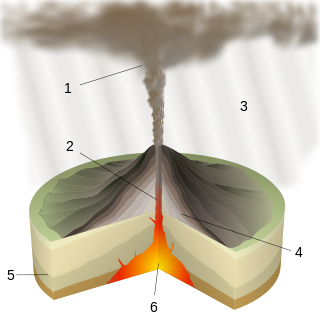
Plinian eruptions or Vesuvian eruptions are volcanic eruptions marked by their similarity to the eruption of Mount Vesuvius in 79 AD, which destroyed the ancient Roman cities of Herculaneum and Pompeii. The eruption was described in a letter written by Pliny the Younger, after the death of his uncle Pliny the Elder.

Haʻapai is a group of islands, islets, reefs, and shoals in the central part of Tonga. It has a combined land area of 109.30 square kilometres (42.20 sq mi). The Tongatapu island group lies to its south, and the Vavaʻu group lies to its north. Seventeen of the Haʻapai islands are inhabited. Their combined population is 5,419. The highest point in the Ha‘apai group, and in all of Tonga, is on Kao, which rises almost 1,050 metres (3,440 ft) above sea level.

The Kermadec–Tonga subduction zone is a convergent plate boundary that stretches from the North Island of New Zealand northward. The formation of the Kermadec and Tonga plates started about 4–5 million years ago. Today, the eastern boundary of the Tonga plate is one of the fastest subduction zones, with a rate up to 24 cm/year (9.4 in/year). The trench formed between the Kermadec–Tonga and Pacific plates is also home to the second deepest trench in the world, at about 10,800 m, as well as the longest chain of submerged volcanoes.
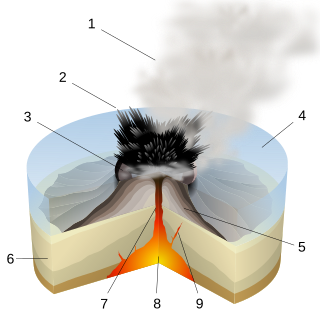
A Surtseyan eruption is an explosive style of volcanic eruption that takes place in shallow seas or lakes when rapidly rising and fragmenting hot magma interacts explosively with water and with water-steam-tephra slurries. The eruption style is named after an eruption off the southern coast of Iceland in 1963 that caused the emergence of a new volcanic island, Surtsey.

Hunga Tonga–Hunga Haʻapai is a submarine volcano in the South Pacific located about 30 km (19 mi) south of the submarine volcano of Fonuafoʻou and 65 km (40 mi) north of Tongatapu, Tonga's main island. It is part of the highly active Kermadec-Tonga subduction zone and its associated volcanic arc, which extends from New Zealand north-northeast to Fiji, and is formed by the subduction of the Pacific Plate under the Indo-Australian Plate. It lies about 100 km (62 mi) above an active seismic zone.
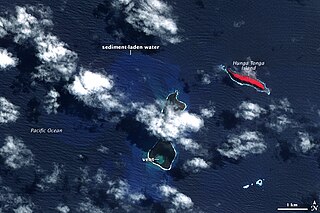
The 2009 Tonga undersea volcanic eruption began on 16 March 2009, near the island of Hunga Tonga, approximately 62 kilometres (39 mi) from the Tongan capital of Nukuʻalofa. The volcano is in a highly active volcanic region that represents a portion of the Pacific Ring of Fire. It is estimated that there are up to 36 undersea volcanoes clustered together in the area.
Liahona High School is a high school in Tonga owned and operated by the Church of Jesus Christ of Latter-day Saints. The school is named after the Liahona, a religious artifact described in the Book of Mormon, which gave a family direction in the wilderness. As of 2022, it is one of six LDS schools on Tongatapu, the main island of Tonga.

The 1808 mystery eruption is one or potentially multiple unidentified volcanic eruptions that resulted in a significant rise in stratospheric sulfur aerosols, leading to a period of global cooling analogous to the Year Without a Summer in 1816.
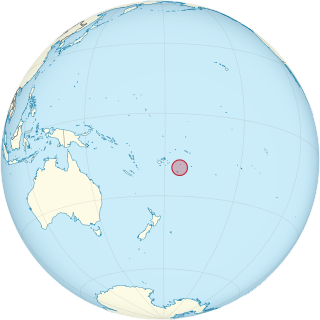
The COVID-19 pandemic was confirmed to have reached Tonga on 29 October 2021 with a traveller who tested positive in quarantine. Several more cases were found in January and February 2022 in a minor outbreak during the aftermath of the 2022 Hunga Tonga–Hunga Ha'apai eruption and tsunami as other countries delivered aid. Tonga had followed a "Covid-free" policy.
This page details the match results and statistics of the Tonga national football team.
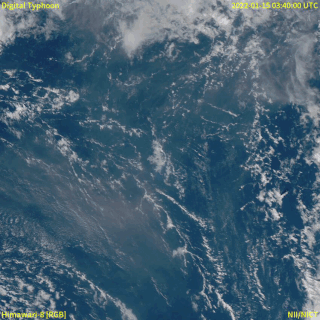
In December 2021, an eruption began on Hunga Tonga–Hunga Haʻapai, a submarine volcano in the Tongan archipelago in the southern Pacific Ocean. The eruption reached a very large and powerful climax nearly four weeks later, on 15 January 2022. Hunga Tonga–Hunga Haʻapai is 65 kilometres (40 mi) north of Tongatapu, the country's main island, and is part of the highly active Tonga–Kermadec Islands volcanic arc, a subduction zone extending from New Zealand to Fiji. On the Volcanic Explosivity Index scale, the eruption was rated at least a VEI-5. Described by scientists as a "magma hammer", the volcano at its height produced a series of four underwater thrusts, displaced 10 cubic kilometres (2.4 cu mi) of rock, ash and sediment, and generated the largest atmospheric explosion recorded by modern instrumentation.

ʻAtatā is an island in Tonga, near the capital city Nukuʻalofa. The island was completely evacuated after the 2022 Hunga Tonga–Hunga Ha'apai eruption and tsunami. Before the eruption, the island's population was 106.
Mango is a small island in Tonga, 9 kilometres south-east of the larger island of Nomuka, and part of the Nomuka or ʻOtu Muʻomuʻa group of islands, which are the southern part of the Haʻapai group. Mango had a population of 62 in the 2021 census.
Events in the year 2022 in Tonga.
The following lists events that happened during 2022 in Niue.

Masilamea is a village on the island of Tongatapu in Tonga. The village had a population of 284 at the 2021 census.